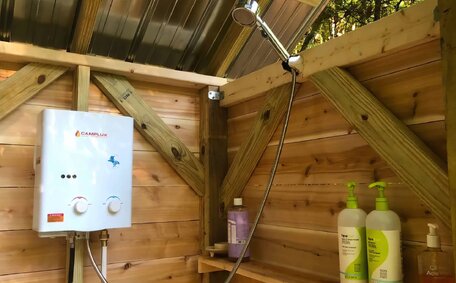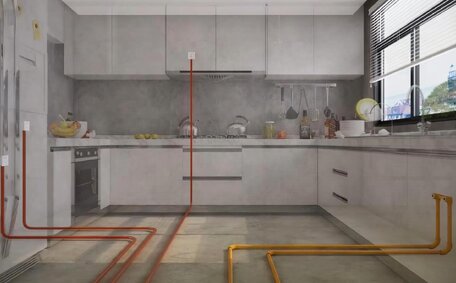
How To Move A Gas Meter
Need your gas meter relocated? You can’t move it yourself - contact your supplier to arrange for a gas engineer to reposition it safely. Charges may apply depending on circumstances.
Read MoreNatural gas and propane, both inherently odourless fossil fuels, have odorants added for safety detection. Natural gas, typically channelled through pipelines, is utilised by various sectors, from residential to industrial. Similarly, propane, though odourless and colourless, has odorants added to ensure safety.
Propane, adaptable in its use and storage, powers home heating, cooking, and vehicles, and is stored in tanks as either a compressed or liquefied gas. While sharing similarities, the key differences between natural gas propane involve energy content, storage, transport, performance, safety, and environmental impacts.
Natural gas is mainly methane but also contains other hydrocarbons like ethane, propane, and butane in smaller amounts. It is formed by the decay of organic materials that have been subjected to intense heat and pressure underground over millions of years.
Sourced deep underground, natural gas is extracted from subterranean wells and shale formations.
Propane is a byproduct of two processes - the refining of crude oil to produce gasoline, diesel, heating oil and other products as well as the processing of natural gas. Approximately the same amount of propane comes from each process. Propane is not directly extracted but is a product of cracking, a process that splits hydrocarbons into simpler molecules.
When comparing energy efficiency, the differences between propane and natural gas reveal themselves in their respective energy contents measured in BTUs (British Thermal Units). Propane generates approximately 2,516 BTUs per cubic foot, outperforming natural gas which produces about 1,030 BTUs.
Thus, propane is more energy-dense, offering more BTUs per unit volume than natural gas. In practical terms, this translates to improved efficiency and performance for propane appliances like furnaces, water heaters, stoves, and vehicles.
Compared to using natural gas, a propane furnace will produce more BTUs of heat from the same fuel volume. This allows propane heaters to heat up faster and propane appliances like stoves to reach higher temperatures.
Conversely, the network of natural gas pipelines negates the requirement for storage tanks and repeated deliveries. And with lower BTU content, natural gas appliances may burn more cleanly and have lower operating costs depending on energy prices. In terms of energy efficiency, propane has the upper hand; however, each fuel type presents its distinct advantages and drawbacks.
When analysing the cost efficiency of propane versus natural gas, it’s important to factor in both the market pricing and energy density of each fuel. While propane is higher in BTU per cubic foot, its cost-effectiveness is also influenced by regional pricing.
In the Menai and greater Sydney locales, residential natural gas costs average roughly $0.06 per cubic foot. Propane pricing is more variable, typically ranging from $0.20 to $0.40 per cubic foot for residential use.
Despite having over double the BTU density, propane is still often more expensive than natural gas per amount energy delivered. However, propane appliances like furnaces tend to utilise the fuel more efficiently thanks to the higher BTU output. Although propane’s initial cost is higher, efficient appliance upgrades can result in significant long-term savings.
It’s also worth noting that with natural gas, additional costs like connection and delivery fees from utilities can affect pricing. Propane, however, necessitates tank rental and delivery costs instead of these fees.
In the end, choosing between cost efficiency of natural gas vs propane depends greatly on the regional market, properties of the home, and type of appliances installed. Moreover, fluctuations in both fuels’ prices over time can change their cost-benefit analysis.
Natural gas is delivered through underground pipelines directly to homes and businesses. There are evident differences between natural gas and other fuels, as there are no storage tanks or deliveries required; it flows continuously through the gas utility infrastructure upon connection to a building.
In contrast, Propane is delivered by truck, requiring onsite storage tanks at residences or businesses. These are typically large cylindrical tanks ranging from 120 gallons to a few cubic meters. These tanks, often leased from the supplier, are refilled periodically based on usage.
Outdoor space for installation is a necessity for propane tanks, which store the fuel in its gaseous form.
In Sydney and Menai’s commercial sector, the use of natural gas cng is signified by the delivery of propane in high-capacity 5,000+ gallon storage tanks. And small portable propane tanks under 40 lbs are common for outdoor use with grills, heaters, and generators. Adequate on-site storage and well-planned delivery schedules are crucial for propane reliance.
While natural gas delivery is more seamless through pipelines, propane’s use of storage tanks necessitates planning ahead for refills. And access issues can make deliveries more difficult. But propane tanks also provide fuel source redundancy if gas pipelines are disrupted.
When it comes to installation, natural gas systems require trained technicians to extend gas lines and properly connect appliances to fuel sources. To guarantee safety and prevent leaks, strict compliance with ventilation guidelines is mandatory.
Propane systems also need certified experts for tank settings, gas line extensions, and appliance conversions or installations. Similar importance lies in proper ventilation, leak detection, and safety shutdown mechanisms.
In maintenance terms, natural gas appliances need more frequent servicing compared to propane units, which often last beyond 20 years owing to the cleaner-burning fuel. Regular inspections for wear or obstructions in both fuels’ pipes and ventilation systems are essential.
On the whole, propane systems involve greater upfront installation costs but lower long-term servicing expenses compared to natural gas. And while natural gas pipelines eliminate delivery needs, any disruptions can impact service. Propane’s on-site storage ensures a consistent backup fuel supply.
When it comes to environmental impacts, propane is considered the cleanest burning fossil fuel and emits less carbon dioxide and other greenhouse gases per BTU than natural gas. According to the Propane Education & Research Council, propane can reduce CO2 emissions by at least 20% compared to natural gas.
This is partly attributed to propane’s higher hydrogen-to-carbon ratio. This cleaner combustion also results in reduced emissions of air pollutants like nitrogen oxides. Propane also does not pose contamination risks for soil or water sources in the event of spills or leaks.
Meanwhile, the main component of natural gas, methane, is estimated to have 25 times greater global warming potential than CO2 if released directly into the atmosphere. Along with other pipeline leaks and accidents, this “fugitive methane” contributes significantly to natural gas’ overall environmental footprint.
However, natural gas pipelines eliminate transportation emissions associated with propane delivery. Given its lower BTU content, natural gas appliances might achieve reduced total emission levels, which varies based on their efficiency.
Ultimately, propane appears to have an edge over natural gas when it comes to direct emissions and immediate environmental impacts. But for a fuller understanding, a life cycle analysis model should be used to capture all embedded emissions in production, infrastructure, transportation, and usage.
When using flammable gases like natural gas and propane, safety should always be the top priority. Since propane is heavier than air, leaks tend to sink and pool in low spots, creating explosion risks in enclosed spaces if ignited. Annual inspections by certified propane professionals help ensure detection of any leaks.
For natural gas, allowences and ventilation guidelines must be strictly followed, especially in basements. Any suspected leaks should be addressed immediately by trained technicians as escaping gas can saturate a room undetected. Maintenance for both fuel systems should never fall behind schedule.
Equipping all propane storage tanks and natural gas lines with auto shut-off valves adds another layer of protection against leaks or ruptures. These safety valves activate before dangerous gas concentration levels are reached within a building or room.
Use of basic safety measures when handling propane cylinders or refuelling vehicles helps to avert fire hazards. Risk reduction includes keeping clear of ignition sources while fuelling, securely closing valves after refilling, and properly storing tanks upright.
Adhering to usage guidelines for natural gas or propane appliances keeps inhabitants secure while enjoying the efficiency of gas. But ultimately, investing in regular professional inspection and maintenance is the best way to prevent avoidable accidents for either system.
When weighing the difference between propane and natural gas for installation, several key factors need consideration for your home or business needs:
Particularly in Menai, propane is readily delivered to most establishments and residences possessing sufficient outdoor tank storage. This provides a reliable fuel source with versatile applications and environmental perks. Just be sure to budget for periodic filling fees and higher winter usage rates.
Specialised commercial solutions integrating both natural gas and propane may also give you the best of both worlds. Contact Menai Plumbing at 1300 349 338 to discuss your best options.
Need your gas meter relocated? You can’t move it yourself - contact your supplier to arrange for a gas engineer to reposition it safely. Charges may apply depending on circumstances.
Read MoreInvesting in a solar hot water system can save up to 75% on water heating costs. With great returns and added home value, solar hot water can be a smart choice over electric or gas heaters. Contact us to see if it’s the right investment for your home.
Read MoreWhile natural gas and propane can both power appliances in your home, they have notable differences when it comes to BTU output, infrastructure, safety, cost and more. Understanding these key contrasts will help you determine which is better for your specific needs.
Read MoreMenai, 2234 NSW
We will call back as soon as possible.




